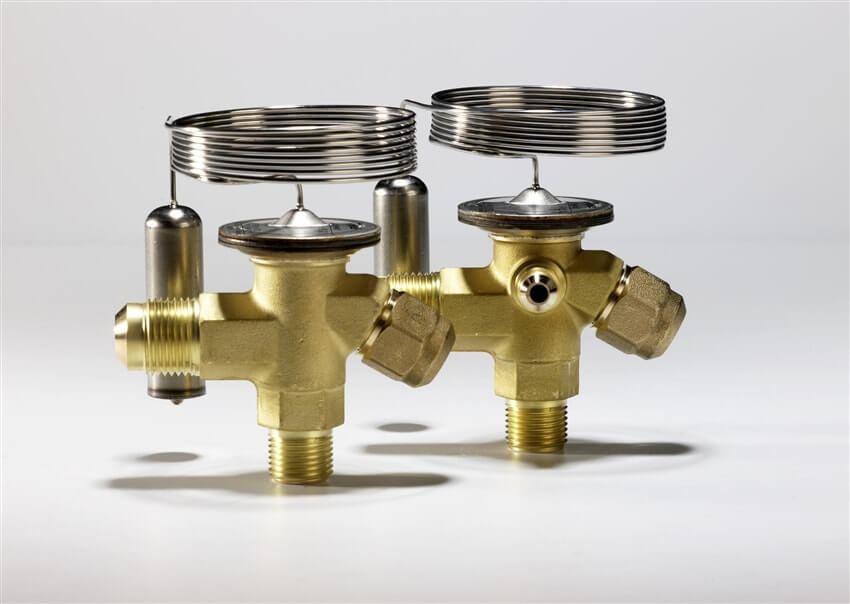Now more and more refrigeration equipment using electronic expansion valve instead of the original thermal expansion valve. Electronic expansion valves and thermal expansion valves have the same basic purpose and a variety of structures, but there are major differences in performance.
Adjustment range
At present, the adjustment range of thermal expansion valve is generally narrow. The heat pump unit is not only for cooling, but also for heating, and the ambient temperature range of applicable occasions is from -15 ℃ to +43 ℃, and the corresponding refrigerant evaporation temperature will work in the range of – 25 ℃ to 5 ℃. Moreover, if there are multiple compressors in the refrigeration circuit, the number of operating compressors will change accordingly with the change of user load, resulting in drastic changes of refrigerant flow.
Therefore, a single thermal expansion valve is far from being able to cope with the operating conditions of large heat pump units. At present, many large heat pump products are equipped with a single compressor in a single circuit design system, and the use of cooling mode and heating mode independent expansion valve system, which will inevitably increase the complexity of the system and manufacturing costs. The electronic expansion valve can be precisely adjusted in the range of 15 % to 100 %.
In the current use of the effect, a single electronic expansion valve can meet the heat pump unit in the above conditions of regulation. The adjustment range can be set according to the characteristics of different products, increasing flexibility.

Control of overheating
- The control point of superheat degree: for thermal expansion valve, generally can only control the evaporator outlet superheat degree. The electronic expansion valve is reflected its superiority, in the semi-hermetic and fully enclosed compressor system, the control point can not only be located in the evaporator outlet, but also can be set in the compressor suction port, that is, to control the suction superheat of the compressor to ensure the efficiency of the compressor.
- The set value of superheat: for thermal expansion valve, the set value of superheat is generally set by the manufacturer in the manufacturing process, usually 5 ℃, 6 ℃ or 8 ℃. The superheat degree of electronic expansion valve can be set according to the different characteristics of the product, such as the evaporator export superheat degree set to 6 ℃, the compressor suction superheat degree can be set to 15 ℃, very flexible.
- The stability of superheat control under non-standard conditions: the set value of superheat of thermal expansion valve is set under standard conditions, and due to the characteristics of the charging medium, when the system deviates from the standard conditions, the superheat often deviates from the set value with changes in condensing pressure, which will not only cause a decline in system efficiency, but also cause the volatility of the system. In contrast, the superheat degree of the electronic expansion valve is set artificially by the controller, and the actual superheat degree of the system is calculated from the parameters of the control point collected by the sensor, so no such problem arises.
- The intelligence of the system regulation: thermal expansion valve for superheat degree control is based on the current state of the control point, determined by the characteristics of the charging process, it can not make a judgment on the trend of the system changes. The control logic of the electronic expansion valve can be based on the design and manufacturing characteristics of different products, using various types of intelligent control systems, it can not only adjust the current state of the system, but also according to the rate of change of superheat and other parameters to discriminate the characteristics of the system, for different system change trends using the appropriate control means. Therefore, its response speed and targeting for system changes is superior to that of thermal expansion valves.

Reaction speed
The actuation of the thermal expansion valve utilizes the thermal characteristics of the charge medium and therefore has the following opening and closing characteristics:
- Sensitivity of response and slowness of opening and closing action.
- In general, the opening and closing speed of the thermal expansion valve is relatively consistent .
- During the start-up of the unit, there is a static superheat degree. The superheat of the thermal expansion valve (SH) consists of static superheat (SS) and opening superheat (OS), and due to the presence of static superheat, there is a tendency to delay the opening of the expansion valve during the start-up process.
The electronic expansion valve is driven by the controller through the calculation of the parameters collected by the sensor, sending adjustment commands to the drive board, which outputs electrical signals to the electronic expansion valve to drive the action of the electronic expansion valve. The electronic expansion valve takes only a few seconds to change from fully closed to fully open state, with fast response and action, no static superheat phenomenon, and the opening and closing characteristics and speed can be set artificially, especially suitable for the use of heat pump units with severe fluctuations in operating conditions.
Diversity of control functions
In order to prevent the pressure and flow rate of refrigerant on the evaporating side from being too large when the unit is initially started, causing overload of the compressor, the general thermal expansion valve is equipped with MOP function, that is, the expansion valve will open only when the evaporating pressure is lower than the set value. However, its function is still monotonous compared with the electronic expansion valve.
The electronic expansion valve can be seen as an organic combination of throttling mechanism and solenoid valve in structure, and it can be adjusted by controller, so according to different product characteristics, it can show its diversity and superiority in control function under the circumstances of unit start-up, load change, defrost, shutdown and fault protection. For example, the regulation of refrigerant flow by electronic expansion valve can be used to regulate the condenser in addition to the evaporator.
When the evaporating condition allows, if the condensing pressure is too high, the expansion valve can be closed appropriately to reduce the flow of refrigerant in the system and lower the condenser load, so as to reduce the condensing pressure and realize the efficient and reliable operation of the unit.

Hi David
How to contact you ?
Hi, you can contact me via my whatsapp: +86 189 2344 0769